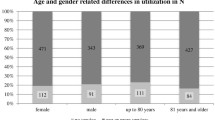Abstract
A two-stage cross-sectional study was conducted in a 951-bed acute-care hospital: a first survey designed to determine the profile of patients aged ≥ 64 years needing supportive social/health care services, in which 38 patients discharged between June and July, 1992 (group 1) with social/health care problems that accounted for inappropriate hospitalization days participated, and a second survey designed to identify patients aged ≥ 65 years at high risk and thus facilitating the early intervention of social workers, in which 153 patients selected at random and interviewed between August and September, 1992 (group 2) participated. A significantly higher percentage of group 1 patients had no medical insurance, were admitted to hospital for treatment, lived alone, had been readmitted in the previous 6 months, suffered from dementia and/or cognitive impairment, presented with associated chronic illnesses, and showed lower Barthel index scores as compared to group 2 patients. In patients in group 2, hospital discharge was delayed due to the need of supportive social and health care services in only 27 patients. The percentage of agreement in the suitability of the resource provided was higher after (92.6%) than before the intervention (71.1%). The mean number of inappropriate hospitalization days was 3.5 days for patients in group 1 and 1.9 days for those in group 2 (p = 0.013). The early identification of elderly inpatients at high risk of needing additional supportive social and health care would help patients to find the most appropriate resource according to their individuals needs.
Similar content being viewed by others
References
Bradsher JE. La utilización de la asistencia sanitaria de los ancianos que viven en la comunidad: Análisis longitudinal. Rev Gerontol 1991; 1: 43–52.
Plan de Salud. Generalitat de Catalunya. Departament de Sanitat i Seguretat Social, Barcelona, 1993.
Ruigómez A, Alonso J, Antó JM. Salud percibida y capacidad funcional de la población anciana no institucionalizada de Barcelona. Gac Sanit 1991; 24: 117–124.
Mahoney FI, Barthel DW. Functional evaluation: The Barthel index. Maryland State Medical Journal 1965; 14: 61–65.
Izquierdo Zamarriego G, Oses Ortega R, Buendía Azaath C. Características de los pacientes geriátricos con reingresos múltiples. Rev Esp Geriatr Gerontol 1991; 26: 55–60.
Wray NP, DeBehnke RD, Ashton CM, Dunn JK. Characteristics of the recurrently hospitalized adult. An information synthesis. Med Care 1988; 26: 1046–1056.
Warshaw GA, Moore JT, Friedman SW, et al. Functional disability in the hospitalized elderly. JAMA 1982; 248: 847–850.
Freeborn DK, Pope CR, Mullooly JP, McFarland BH. Consistently high users of medical care among the elderly. Med Care 1990; 28: 527–540.
Coughlin TA, McBride TD, Liu K. Determinants of transitory and permanent nursing home admissions. Med Care 1990; 28: 616–631.
Kiel DP, O'Sullivan P, Teno JM, Mor V. Health care utilization and functional status in the aged following a fall. Med Care 1991; 29: 221–228.
Murtaugh CM, Kemper P, Spillman BC. The risk of nursing home use in later life. Med Care 1990; 28: 952–962.
Roos NP, Roos LL, Mossey J, Havens B. Using administrative data to predict important health outcomes. Entry to hospital, nursing home, and death. Med Care 1988; 26: 221–239.
Guillén Lera F. Envejecimiento, enfermedad, incapacidad. Rev Esp Geriatr Gerontol 1991; 26: 338–348.
Katz S, Downs TD, Cash HR, Grotz RC. Progress in development of the index of ADL. Gerontologist 1970; 10: 20.
Katz S, Ford AB, Moskowitz RW, Jafe MW. Study of illness in the aged. The index ADL: A standardized measure of biological and psychosocial function. JAMA 1963; 185: 914–919.
Reuben DB, Siu AL. An objective measure of physical function of elderly outpatients. The Physical Performance Test. J Am Geriatr Soc 1990; 38: 1105–1112.
Williams ME, Gaylord SA, McGaghie WC. Timed manual performance in a community elderly population. J Am Geriatr Soc 1990; 38: 1120–1126.
Podsiadlo D, Richardson S. The Timed ‘Up & Go’: A test of basic functional mobility for frail elderly persons. J Am Geriatr Soc 1991; 39: 142–148.
Siu AL, Reuben DB, Hays RD. Hierarchical measures of physical function in ambulatory geriatrics. J Am Geriatr Soc 1990; 38: 1113–1119.
Granger CV, Albrecht GL, Hamilton BB. Outcome of comprehensive medical rehabilitation: Measurement by PULSES profile and the Barthel index. Arch Phys Med Rehabil 1979; 60: 145–153.
Smith D. Activities of daily living as quantitative indicators of nursing effort. Med Care 1987; 25: 120–30.
Author information
Authors and Affiliations
Rights and permissions
About this article
Cite this article
Lledó, R., Martín, E., Jiménez, C. et al. Characteristics of elderly inpatients at high risk of needing supportive social and health care services. Eur J Epidemiol 13, 903–907 (1997). https://doi.org/10.1023/A:1007420911766
Issue Date:
DOI: https://doi.org/10.1023/A:1007420911766



